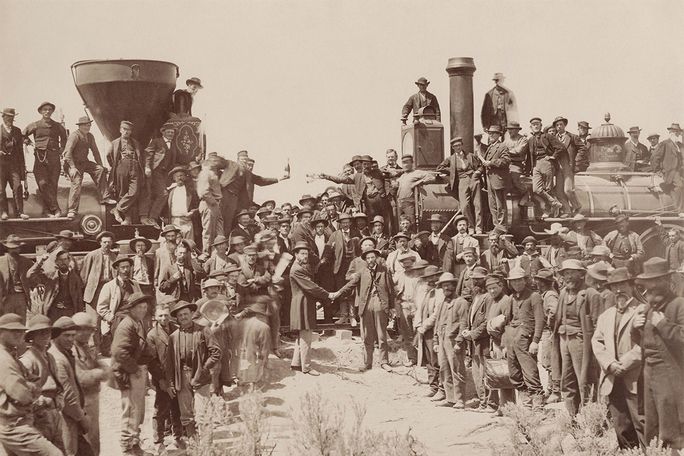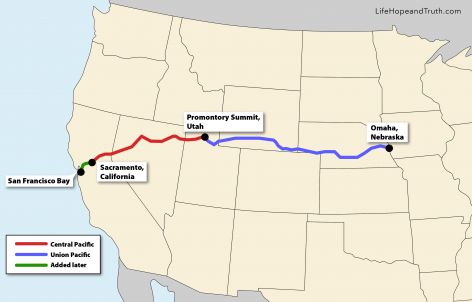The Transcontinental Railroad and Bible Prophecy
Few people today give much thought to railroads or how they have impacted history. But the story of one railroad reminds us of God’s faithfulness to a promise He made thousands of years ago.

May 10, 2019, marks the 150th anniversary of the completion of the American Transcontinental Railroad—a monumental engineering achievement that laid almost 2,000 miles of railroad track over the western plains and mountains of North America.
On May 10, 1869, a golden spike was driven into a railroad tie at Promontory Summit, Utah, marking the completion of the first railroad connecting the U.S. East Coast to the West Coast. With this spike, the rails of the Union Pacific Railroad and Central Pacific Railroad were joined, and the expansion and development of the United States “from sea to shining sea” became possible.
The land opened up by the railroad—and the vast resources it contained—would provide the natural resources to help build what would become the greatest single nation in modern history.
But as a backdrop to this event, we need to look back in history about 4,000 years.
A promise of growth and wealth
In Genesis 22 we read about how God tested Abraham with an intense trial of faith. God asked Abraham to sacrifice his son Isaac (verse 2). As difficult as it must have been, Abraham was willing to obey God’s command, knowing that God could raise Isaac back to life. But as Abraham raised the knife to end his son’s life, God stopped him at the last moment (verses 11-12).
Following this incredible display of faith, which foreshadowed the sacrifice God would give for us, God made a promise to Abraham: “By Myself I have sworn, says the LORD, because you have done this thing, and have not withheld your son, your only son—blessing I will bless you, and multiplying I will multiply your descendants as the stars of the heaven and as the sand which is on the seashore; and your descendants shall possess the gate of their enemies” (verses 16-17).
God promised great material blessings to Abraham’s descendants.
Those blessings were passed on to Abraham’s offspring with more details given. To his grandson Jacob, God said: “I am God Almighty. Be fruitful and multiply; a nation and a company of nations shall proceed from you, and kings shall come from your body” (Genesis 35:11).
These promises would later be passed on to Jacob’s son Joseph and then divided between Joseph’s two sons, Ephraim and Manasseh (Genesis 48:19). Our booklet The United States, Britain and the Commonwealth in Prophecy explains how these promises were fulfilled in modern times. In short, Ephraim’s descendants became a company of nations spread throughout the globe (today among the peoples of the British Commonwealth), and Manasseh’s descendants became one single great nation (the United States of America).
Opening up the land of promise
Now back to the story of the Transcontinental Railroad.
Back in the 19th century, the United States (then a young and undeveloped nation) needed territory and resources. The Great Plains and the West offered both. This territory was filled with a richness of natural resources, towering mountains, thundering rivers, majestic canyons and vast amounts of land ready to be settled by a nation pushing west.
But there was a major problem: How would people, goods and resources be moved back and forth across this mammoth stretch of land that included wild and rugged terrain?

These were three hard, expensive, time-consuming and dangerous options.
With the invention of the steam engine, trains now offered a much more efficient means of transporting people and goods over long distances. Railroad tracks began to be laid in the East, and by 1850 more than 9,000 miles of track had been laid east of the Missouri River. So in order for the young nation to expand into its yet untamed western lands, a railroad needed to be constructed that provided a fourth option for westward travel.
The discovery of gold in California and silver in Nevada increased the need to build a secure rail route back to the East Coast.
After several years of haggling and discussing it, the U.S. Congress finally passed the Pacific Railway Act of 1862, which would award 12,800 acres of land and $48,000 in government bonds for every mile of track built. This made it possible for the two large railroad companies (the Central Pacific and the Union Pacific) to commit huge amounts of capital and employ a vast labor force to forge a rail line from Omaha, Nebraska, to Sacramento, California. They began working at each end, racing to meet someplace in the middle.
Challenges of the task
The risks and engineering challenges were many.
In order for railroad track to stretch across the massive expanse of land, rivers and canyons would have to be bridged, mountains would have to be traversed, and solid rock would have to be blasted through to create tunnels. This all required careful mapping, brilliant engineering and a massive workforce.
Food, water and shelter would have to be supplied for the thousands of men doing the work. Hundreds of thousands of rails would have to be forged and transported in a constant supply chain, along with the wood for ties and bridges—not to mention all the tools the men would need and the millions of railroad spikes required!
There were also many logistical hazards to deal with. Across the plains, workers often faced attacks by Native Americans, who resented the intrusion of these men and their “iron horse.” Such attacks slowed progress, and guards had to be alert day and night.
All across the West crews faced extremes of weather—especially winter on the plains and in the mountains. Massive storms would often bring construction and supply lines to a standstill. To build 2,000 miles of railroad was a massive and expensive undertaking—but the potential rewards were equally massive!
The face of a nation was forever changed
When the final ceremonial spike was driven in Promontory Summit, Utah, on May 10, 1869, the engineers from both companies brought their steam engines up until their pilots (also known as “cowcatchers”) touched. The Transcontinental Railroad was at last complete!
How does this tremendous achievement connect with God’s promises to Abraham discussed above? It played a big part in the phenomenal growth of the United States into a great world power.
Almost immediately, the railroad created revolutions in the still young country. The rugged and dangerous frontier that had kept many from traveling west essentially vanished overnight. Travel from New York to California had previously taken upwards of six months and cost about $1,000 per person (the equivalent of almost $20,000 in today’s currency). With the opening of the railroad, it took one week and cost about $150 (or about $3,000 in today’s currency). This opened the door for settlers to move west quickly and in much larger numbers.
The rugged and dangerous frontier that had kept many from traveling west essentially vanished overnight.
As the population grew, there was a twofold effect on the economy. First, many new jobs were added that would have never existed without the Transcontinental Railroad. Work became abundant in the western mines and in the timber and cattle industries. New markets opened up as shops and services were needed by newly established and rapidly growing towns. The newly opened lands and opportunities also drew thousands of immigrants from other countries to the U.S., swelling the population and labor base.
With ready access to railroads, within a few years over $50 million worth of freight was being shipped from coast to coast every year. The huge markets that were opened up were a boon to agriculture, as fresh fruits and vegetables grown in California could now be shipped to the East Coast before they spoiled.
It has been said that the railroad put America in motion in more than one sense. It was a major contributor to the industrial boom of the late 19th and early 20th centuries and changed the face of the nation and its culture. The cowboy and Native American cultures began to diminish, replaced by towns and cities.
Even the concept of time was changed, as the population went from telling time by the sun to “railroad time,” designed to note precisely when a locomotive would arrive and depart. This eventually led to the development of time zones.
The Transcontinental Railroad and its effects contributed greatly to the fulfillment of God’s promises to the descendants of Manasseh. It truly helped the United States become a great nation.
Date Posted: May 10, 2019



